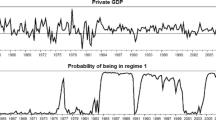Abstract
This paper presents a two-country dynamic perfect foresight Ricardian model with wealth effects to study the relationship between government spending financed by alternative taxation, the terms of trade and welfare. An increase in domestic government spending financed by a distortionary capital income tax leads the real exchange rate initially to appreciate (a pure demand effect). But along the transitional path an intertemporal terms of trade effect (a supply side effect) operates and the real exchange rate depreciates to a steady state value ultimately higher relative to the initial equilibrium. The welfare of the domestic resident increases due to a reversed immiserizing growth effect.
Similar content being viewed by others
References
Backus, D., P. Kehoe and F. Kydland. (1994). “Dynamics of the Trade Balance and the Terms of Trade: The J Curve?” American Economic Review 84, 84–103.
Becker, R. A. (1980). “On the Long Run Steady State in a Simple Dynamic Model of Equilibrium with Heterogeneous Households.” Quarterly Journal of Economics 95, 375–382.
Bhagwati, J. (1968). “Distortions and Immiserizing Growth: A Generalization.” Review of Economic Studies 33, 481–485.
Bianconi, M. (1995). “Fiscal Policy in a Simple Two-Country Dynamic Model.” Journal of Economic Dynamics and Control 19, 395–419.
Bianconi, M. and S. J. Turnovsky. (1997). “International Effects of Government Expenditure in Interdependent Economies.” Canadian Journal of Economics 30, 57–84.
Braun, M. (1983). Differential Equations and their Applications, 3rd ed. New York, NY: Springer-Verlag.
Brock, P. L. and S. J. Turnovsky. (1993). “The Growth and Welfare Consequences of Differential Tariffs.” International Economic Review 34, 756–794.
Cantor, R. and N. C. Mark. (1988). “The International Transmission of Real Business Cycles.” International Economic Review 29, 493–507.
Chinn, M. D. and L. Johnston. (1996). “Real Exchange Rate Levels, Productivity and Demand Shocks: Evidence from a Panel of 14 Countries.” NBER Working Papers Series No. 5709, April. Cambridge, MA.
Chinn, M. D. (1999). “Sectoral Productivity,Government Spending, and Real Exchange Rates: Empirical Evidence for OECD Countries.” In R. MacDonald and J. Skin (eds.). Equilibrium Exchange Rates, Kluwer Academic Publishers, 163–190.
Chinn, M. D. (2000). “The Usual Suspects? Productivity and Demand Shocks and Asia-Pacific Real Exchange Rates.” Review of International Economics 8, 20–43.
Froot, K. A. and K. Rogoff. (1991). “Government Consumption and the Real Exchange Rate: The Empirical Evidence.” Unpublished Manuscript, Harvard Business School. August.
Kim, S. H. (2001). “Capital Income Taxation in an Open Economy: Implications for Business Cycles and Welfare.” Unpublished manuscript, Brandeis University. February.
Lee, Y. (1995). “The Effects of Fiscal Policy in a Two-Country World Economy: An Intertemporal Analysis.” Journal of Money Credit and Banking 27, 135–159.
Mussa, M. (1986). “Nominal Exchange Rate Regimes and the Behavior of Real Exchange Rates.” In Real Business Cycles, Real Exchange Rates, and Actual Policies. Carnegie-Rochester Conference Series, North Holland: Amsterdam.
Obstfeld, M. (1989). “Fiscal Deficits and Relative Prices in a Growing World Economy.” Journal of Monetary Economics 23, 461–484.
Sen, P. and S. J. Turnovsky. (1990). “Investment Tax Credit in an Open Economy.” Journal of Public Economics 42, 277–309.
Stockman, A. and L. Tesar. (1992). “Tastes and Technology Shocks in a Two-Country Model of the Business Cycle: Explaining International Comovements.” American Economic Review 85, 168–185.
Turnovsky, S. J. (1997). International Macroeconomic Dynamics. Cambridge, MA: The MIT Press.
Turnovsky, S. J. and M. Bianconi. (1992). “The International Transmission of Tax Policies in a Dynamic World Economy.” Review of International Economics 1, 49–72.
Turnovsky, S. J. and P. Sen. (1991). “Fiscal Policy, Capital Accumulation and Debt in a Small Open Economy.” Oxford Economic Papers 43, 1–24.
Author information
Authors and Affiliations
Rights and permissions
About this article
Cite this article
Bianconi, M. Fiscal Policy and the Terms of Trade in an Analytical Two-Country Dynamic Model. International Tax and Public Finance 10, 25–41 (2003). https://doi.org/10.1023/A:1022224928986
Issue Date:
DOI: https://doi.org/10.1023/A:1022224928986




